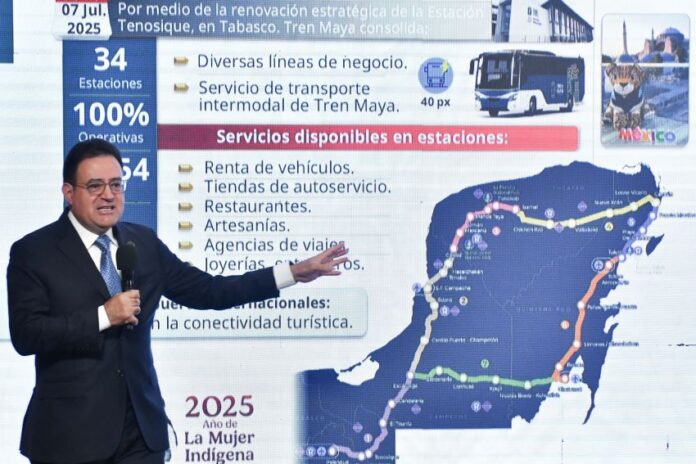The freight service of the Maya Train in the Yucatan Peninsula is expected to be up and running by the end of 2026, Mexico’s President Claudia Sheinbaum said last week.
“It will be two years of construction, in 2025 and 2026,” stated Sheinbaum at her Wednesday press conference. “We hope to be inaugurating at the end of 2026.”
During the press conference, General Gustavo Ricardo Vallejo Suárez, director of the Felipe Ángeles Engineering Contingent, discussed the progress of the freight project.
The Maya Train’s passenger service has been wholly operational since July 7, with 34 stations across the Yucatan covering 1,554 kilometers. Meanwhile, work on a Maya Train freight network commenced in April and is expected to be completed by November next year.
The freight network will include four main transfer terminals: Palenque, Poxilá, Progreso and Cancún.
Military engineers plan to rehabilitate 70 kilometers of railway, starting in the city of Mérida, to connect local industry with the existing Maya Tren railway line. The line will then be extended to Yucatán’s main port of Progreso to facilitate cargo transportation.

The military is developing the Progreso Multimodal Cargo Terminal in collaboration with port authorities, the state government and the Maya Train group, to prepare to launch operations in late 2026, Vallejo said.
The Maya Train will eventually connect with the national railway network, he said, allowing for freight to move from Mexico’s northern borders to Chetumal and Cancún in the south.
The government aims to expand the railway network to the Nogales, Sonora, on the northern border by the end of Sheinbaum’s six-year term in office, in 2030.
The team is also working with the National Institute of Anthropology and History (INAH) to excavate archaeological relics encountered along the route.
Vallejo stressed the importance of environmental protection, saying his team plans to relocate tree and wildlife species to protected natural areas.
“It is complicated in terms of its topography,” said Vallejo. “Every day, we move more than 15,000 cubic meters of materials.”
Vallejo said the resources, permits, personnel and machinery are ready to commence works across the freight network. Project progress stands at approximately 5%, he said, with greater progress expected once the INAH completes its preservation work.
Mexico News Daily
